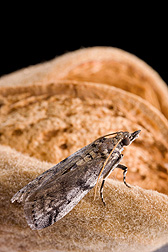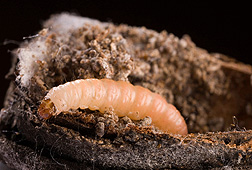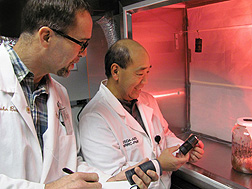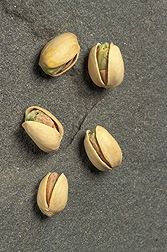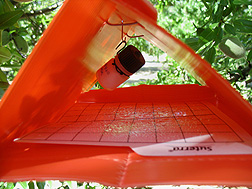New Lure May Help Growers Combat Almonds’ No. 1 Insect Pest
Navel Orangeworm
|
|
It’s no wonder that almonds are one of America’s favorite nuts. They taste great and are heart-healthy, too.
Most of the almonds grown in the United States today come from vast orchards in California. For the past 50 years, however, the Golden State’s almond harvests have been threatened by what is today the number-one insect pest of almonds—the navel orangeworm.
The troubles begin when the female navel orangeworm moth lays her eggs on the exterior of the almond hull, also called its “husk.” The husk protects the layers beneath it, notably the light-tan almond shell and the nutmeat that develops within it.
Female moths are attracted to almonds with husks that have split open—which happens naturally as the nut matures. Other sorts of damage also have appeal, such as entry holes left by other insects, or injury caused when a husk is slammed against a nearby branch on a windy day.
Each kind of injury may make it easier for the navel orangeworm larvae that hatch from the eggs to find their way to food (the nutmeat) and the shelter of the husk’s interior.
But the harm that the larvae cause doesn’t stop there. They wreak further havoc when they inadvertently bring spores of mold-forming Aspergillus flavus or A. parasiticus fungi along with them as they make their way to the almond kernel. The fungi are of concern because they can produce cancer-causing compounds known as “aflatoxins.” Almond processors spend millions of dollars every year inspecting harvested almonds to ensure that any nuts that contain unsafe levels of these toxins don’t end up in your shopping cart.
|
|
A Better Lure
Some almond growers hang small traps on tree branches to help detect incoming navel orangeworm moths and track their numbers. This way, the growers, and their pest control advisors, can determine the best times to apply insecticides.
Typically, these “monitoring traps” are baited with a lure that attracts the female moths. That lure is usually almond meal (almonds ground to a cornmeal-like texture) to which almond oil may have been added.
Now, a team of Agricultural Research Service and almond industry investigators, led by ARS chemist John Beck in Albany, California, has developed a promising new lure. According to Beck, the lure proved to be “at least seven times more powerful” than the almond-meal-based formulation in preliminary tests.
The new lure’s effectiveness is due, in part, to its ability to attract both male and female moths. In so doing, it should provide a more accurate and useful picture of moth numbers within an orchard, Beck says.
|
|
The lure is a unique, carefully researched blend of five natural chemicals. Known to scientists as “aromatic volatiles,” these compounds are emitted into the orchard air from damaged almond husks. Beck’s team used leading-edge techniques to collect, isolate, identify, and measure the compounds, and used electroantennograph assays to select and compare finalists.
The electroantennograph tests enabled the researchers to evaluate, in the laboratory, the extent to which navel orangeworm moth antennae responded to a “whiff” of a candidate chemical.
Three of the chemicals selected for the experimental blend—acetophenone, ethyl benzoate, and methyl salicylate—are produced by the almond tree itself. The other two, conophthorin and 1-octen-3-ol, are emitted by spores of fungi that may dwell on almond trees, including A. flavus and A. parasiticus.
The blend resulted from about 7 years of laboratory and orchard research. Outdoor tests included a 3-year experiment that pitted the blend against the standard almond-meal lure. The scientists used more than 100 traps, distributed throughout 2 commercial almond orchards, for the research.
Each of the individual compounds in the blend was already known to exist in nature, and all were previously known to have some role in insect ecology. At least one—conophthorin—has been suggested for use in insect control, specifically, control of bark beetles that attack forest trees. But the five compounds had not—until now—been combined for use as an effective navel orangeworm lure. ARS is currently seeking a patent for the formulation.
More Discoveries Ahead
Much remains to be learned about the blend, its use, and some of its components. An example: Beck and colleagues want to guarantee that the lure is compatible with “mating disruption,” an environmentally friendly pest-control strategy used in many almond orchards. This well-established tactic relies on dispersing a synthetic version of the sex pheromone emitted by female navel orangeworm moths. Normally, male moths home in on the pheromone to find mates. But the oversupply of the pheromone can confuse them and disrupt mating.
“Our lure should be compatible with mating disruption,” Beck says, “but we want to be certain of that.”
In addition, the researchers want to make the lure more effective in pistachio orchards, which also are vulnerable to attack by the navel orangeworm. Their experiments have shown that the current blend works in pistachio orchards, but not as well as it does with almonds.
|
|
The team also plans to tailor the lure to work effectively in walnut orchards, where the insect is sometimes a major pest of that crop.
There’s more. The scientists are tackling the problem of how to keep the ratio of blend components stable. Maintaining the correct ratio is essential to the lure’s success, but it is complicated by the fact that the compounds evaporate at different rates.
Other work may yield a fast, easy way to dispense the lure. “It’s a liquid, and right now we’re using small plastic vials filled with about a half-teaspoon of it in the monitoring traps,” Beck says. “We’d rather use something like a small pouch that’s impregnated with the lure. All you’d have to do to start releasing the lure would be to peel the cover off the pouch.”
Perhaps the most intriguing study on their “to-do” list involves probing into what may turn out to be a mutually beneficial relationship that might have evolved between the moths and the molds. “We think that these Aspergillus molds, and some other mold species that can occur in almond orchards, may help the female navel orangeworm moth by giving off aromatic volatiles that attract her to a damaged husk,” Beck explains. “The moth is looking for a good place to lay her eggs. If the moth lays her eggs on a damaged husk, her larval young should benefit because they won’t have to crawl far to find food and shelter. The mold benefits because its spores get a free ride on the larvae into the interior of the husk. That’s a more hospitable environment than the exterior for spore development.”
If such mutualism does indeed exist, the researchers might be able to exploit it in a strategy that harms moth and mold alike.
Beck, who is based at the ARS Western Regional Research Center in Albany, collaborated in the lure studies with ARS colleagues Doug Light, Noreen Mahoney, and Wai Gee—all at Albany; Dan Cook, with ARS in Parlier, California; Brad Higbee of Paramount Farming Co., LLC; and others.
Peer-reviewed scientific articles published in the Journal of Agricultural and Food Chemistry, Journal of the Science of Food and Agriculture, Phytochemistry Letters, and elsewhere, as well as a chapter in the book “Pest Management with Natural Products,”document their studies.
The research was conducted with funding from ARS, the California Department of Food and Agriculture, the Almond Research Board, the California Pistachio Research Board, a cooperative research and development agreement with Paramount Farming and with the assistance of other collaborators, including D&D Farms, S&J Ranch, Strain Ranches, and Nickels Soil Laboratory.—By Marcia Wood, Agricultural Research Service Information Staff.
This research is part of Food Safety, an ARS national program (#108) described at www.nps.ars.usda.gov.
John J. Beck is with the USDA-ARS Western Regional Research Center, 800 Buchanan St., Albany, CA 94710; (510) 559-6154.
"New Lure May Help Growers Combat Almonds’ No. 1 Insect Pest: Navel Orangeworm" was published in the August 2014 issue of Agricultural Research magazine.







